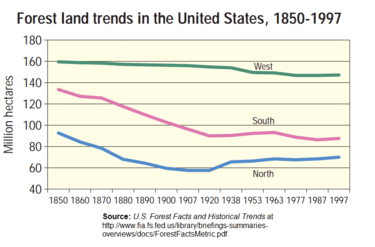Forests of the United States

It has been estimated that before European settlement, forests in the United States covered nearly 1,000 million acres (4,000,000 km2). On the other hand, the arrival of Europeans caused a decline in native populations, and since the natives were largely agricultural, this caused reforestation of agricultural lands.[1] Since the mid-1600s, about 300 million acres (1,200,000 km2) of forest have been cleared, primarily for agriculture during the 19th century. Today about one-third of the nation is forested. While total forest area has been relatively stable for the last 100 years (currently about 747 million acres (3,020,000 km2)), there have been significant regional shifts in the area and composition of the nation's forests. Reversion of marginal farmland in the east, large scale planting in the South, and fire suppression have contributed to increases in forest area. Urbanization, conversion to agriculture, reservoir construction, and natural disasters have been major factors contributing to loss of forests.[2] As of 2005, the United States ranked seventh in the rate of loss of its old growth forests.[3]
Eastern forests cover about 384 million acres (1,550,000 km2) and are predominantly broadleaf (74%), with the exception of extensive coniferous forests and plantations in the southern coastal region. These are largely in private ownership (83%). By contrast, about 363 million acres (1,470,000 km2) of western forests are predominantly coniferous (78%) and in public ownership (57%). Nearly ten million private individuals own about 422 million acres (1,710,000 km2) of forest and other wooded land. Most public forest land is held by four Federal agencies (United States Forest Service, Bureau of Land Management, National Park Service, Fish and Wildlife Service) as well as numerous state, county, and municipal government organizations.[2]
Major uses of forests include timber production, recreation, hunting, fishing, watershed and fisheries protection, wildlife habitat and biodiversity protection, and gathering nontimber products such as berries, mushrooms, and medicinal plants.[2]
See also
- Deforestation in the United States
- Forest cover by state in the United States
- List of U.S. National Forests
- National Park Service
- Senate Committee on Forest Reservations and the Protection of Game
- United States Forest Service
- François André Michaux, a botanist noted for his work on the trees found in America
References
- ↑ Simon Lewis; Mark Maslin (Mar 11, 2015). "Defining the Anthropocene". Nature. doi:10.1038/nature14258.
- 1 2 3
 This article incorporates public domain material from the nationalatlas.gov document "Forest Resources of the United States".
This article incorporates public domain material from the nationalatlas.gov document "Forest Resources of the United States". - ↑ "Global Forest Resources Assessment 2005". UN Food and Agriculture Organization. 2005.
